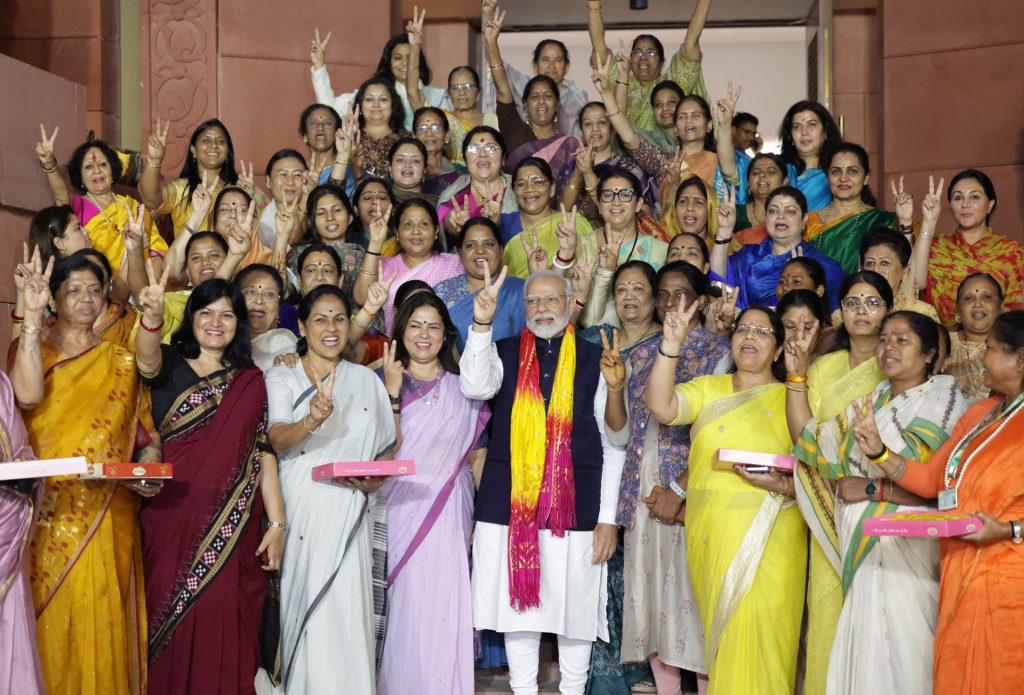
While most opposition parties back the bill for 33% women’s reservation in both houses of parliament, they also demand some modifications arguing that the current bill neglects the diversity and complexity of women’s representation in India.
The Modi administration has gained reputation for launching unexpected initiatives, from demonetization and the implementation of the GST to imposing lockdowns during the COVID-19 pandemic and calling for special sessions of Parliament. The most recent surprise move was the announcement of a special parliamentary session, leaving everyone speculating about the topics that would be discussed. However, the agenda was revealed on the opening day of the session when the Modi government introduced the Women’s Reservation Bill of 2023 in the Lok Sabha on September 20, 2023.
The 2023 Women’s Reservation Bill, also referred to as the Nari Shakti Vandan Adhiniyam, is a proposed constitutional amendment aiming to reserve one-third of seats in both the Lok Sabha and state assemblies for women, and on September 21, 2023, this bill garnered overwhelming support in both the Lok Sabha and Rajya Sabha, with 454 votes in favour and only two opposing votes. However, for the bill to become law, it must still receive ratification from at least half of the state legislatures.
The Bill aspires to embolden them to play a more pivotal role in shaping policy while addressing the critical issue of women’s under-representation in the realm of Indian politics. This endeavour not only carries the potential to elevate India’s standing in the global arena but is also driven by the sobering statistics presented in a March 2023 report from the Inter-Parliamentary Union. The stats say that currently, India languishes at the 148th position out of 193 nations when it comes to female representation in the Lower House of Parliament, with a mere 14.4% of seats occupied by women and this predicament assumes an even graver dimension within state assemblies, where the presence of women MLAs varies significantly, ranging from a stark absence to a maximum of 15 percent across states.
The key provisions of the Women’s Reservation Bill
The Women’s Reservation Bill of 2023 aims to achieve gender parity and social diversity in the Indian Parliament and state assemblies by reserving 33% of seats for women, including those from SCs and STs. The bill also introduced a rotational system that would change the reserved seats after every election, ensuring a varied representation of women from different constituencies. The bill is a bold vision that seeks to empower women and enhance democracy in India.
Crucially, the bill doesn’t merely stop at seat allocation; it delves into the very framework of constituency demarcation by proposing that the delimitation of constituencies should be thoughtfully crafted to ensure the equitable representation of women in these reserved seats, and these intricate provisions, woven into the fabric of the bill, reflect a resolute commitment to fostering a political landscape where women’s voices are not just heard but also elevated to positions of influence.
The Women’s Reservation Bill of 2023, which was introduced by the Modi government in a surprise move, has a long and turbulent history of being proposed and opposed by various governments and parties since 1996. The bill, which aims to reserve 33% of seats for women in Parliament and state assemblies, was passed by the Rajya Sabha in 2010 but failed to clear the Lok Sabha hurdle due to strong protests. The bill remained dormant until the Modi government revived it as part of their women’s empowerment agenda in 2023.
The majority of political parties, encompassing Congress, TMC, DMK, AAP, BSP, SP, CPI(M), NCP, Shiv Sena, and others, have thrown their weight behind the bill; however, a few parties have voiced concerns or requested adjustments to the proposed legislation.
Demand for Modifications in the Bill
Most opposition parties back the bill for 33% women’s reservation in both houses of parliament, but they also want OBC and Muslim women to get a share of this quota by arguing that these women are more disadvantaged and underrepresented than upper caste women and that this view is shared by parties like Congress, RJD, JD (U), AIUDF and AIMIM, and they claim that the current bill only helps the rich and powerful women and neglects the diversity and complexity of women’s representation in India.
Additionally, certain parties contend that postponing the implementation of the quota until after the census and delimitation processes, which may span several years, could unjustly deny the current generation of women their rightful representation, and they also argue that such a delay contradicts the fundamental intent of the Bill. Parties like TMC, AAP and BJD have voiced this concern and proposed that the quota should be promptly enacted using the existing electoral rolls and constituencies, with adjustments made subsequently once the census and delimitation procedures are finalized.
Some parties fear that women’s reservations could harm regional and smaller parties apprehending that the rotation of constituencies could make them lose seats and influence. Parties like TRS, YSRCP and LJP have these doubts, as they think that the reservation system could reduce their chances of winning seats or forming alliances, and affect their regional goals and interests.
In Defence of the Bill
The Modi government has defended the bill as a historic step towards ensuring gender justice and equality in Indian democracy. Apart from the government, proponents of the Bill aver that the main objective of the Bill is to promote gender equality and increase women’s representation in legislative bodies while increasing women’s political participation will lead to more inclusive and balanced decision-making processes and policies. While hailing it as a necessary step towards achieving gender equality and empowering women in the political sphere, they also believe that increased women’s representation will address issues that are of particular concern to women and result in better governance.
The government says that the bill is in line with constitutional provisions, and asserts that the reservation will start after a delimitation exercise based on the first census done after 2026. The government explains that the census and delimitation processes are necessary to ensure fair and equal representation for all regions and communities in both Parliament and state assemblies.
The government argues that the bill’s aim is not to harm or weaken any political entity but to strengthen democracy and empower women, and it stresses that the reservation system will work on a rotational basis, making sure that each constituency is reserved once every three general elections. Moreover, the government also promises that no party or candidate will lose their current seats because of the reservation policy.
While asserting that reservation is not an end in itself, but a means to an end, the government has hailed the bill as a historic step towards ensuring gender justice and equality in Indian democracy. While describing it as a means of empowering women, the government said that it will complement other measures such as education, skill development, social security and legal reforms for improving the status of women in India.
Conclusion
India’s recent adoption of the Women’s Reservation Bill has garnered recognition from the United Nations as a watershed moment in advancing gender equality and promoting women’s leadership in the country. Notably, India’s current standing in the Global Gender Gap Report 2022 places it at 48th out of 146 nations concerning political empowerment. The introduction of this bill is expected to have a positive impact on India’s global ranking while opening up more opportunities for women to engage in the nation’s governance. While the Women’s Reservation Bill signifies a commendable stride toward gender equality, it also underscores the existing challenges. The bill primarily focuses on reserving seats for women in the legislative bodies, leaving a broader need for representation in other decision-making bodies, including government and private sectors unaddressed. Furthermore, the successful implementation of the bill and the active participation of women in politics are pivotal factors for its effectiveness and impact.













